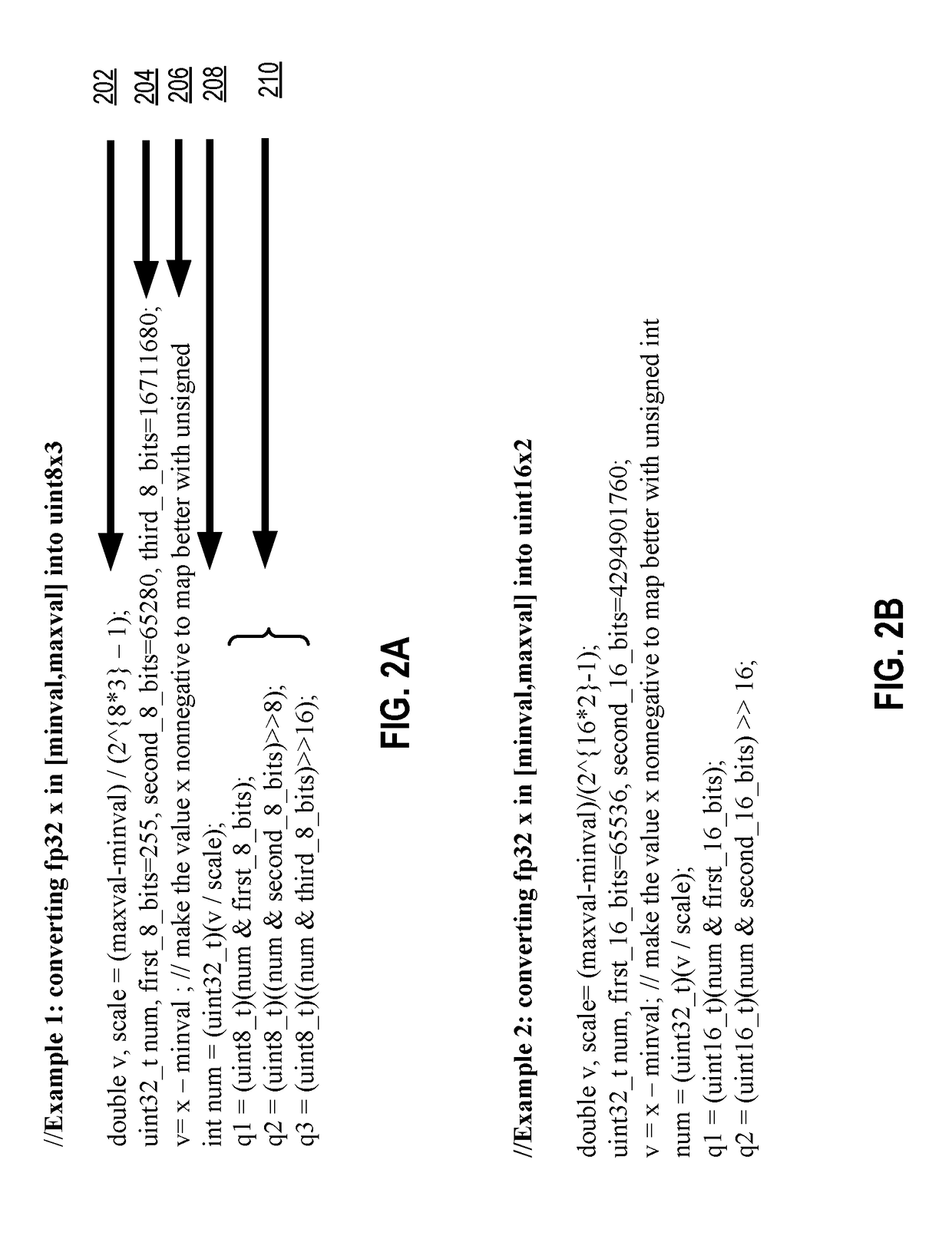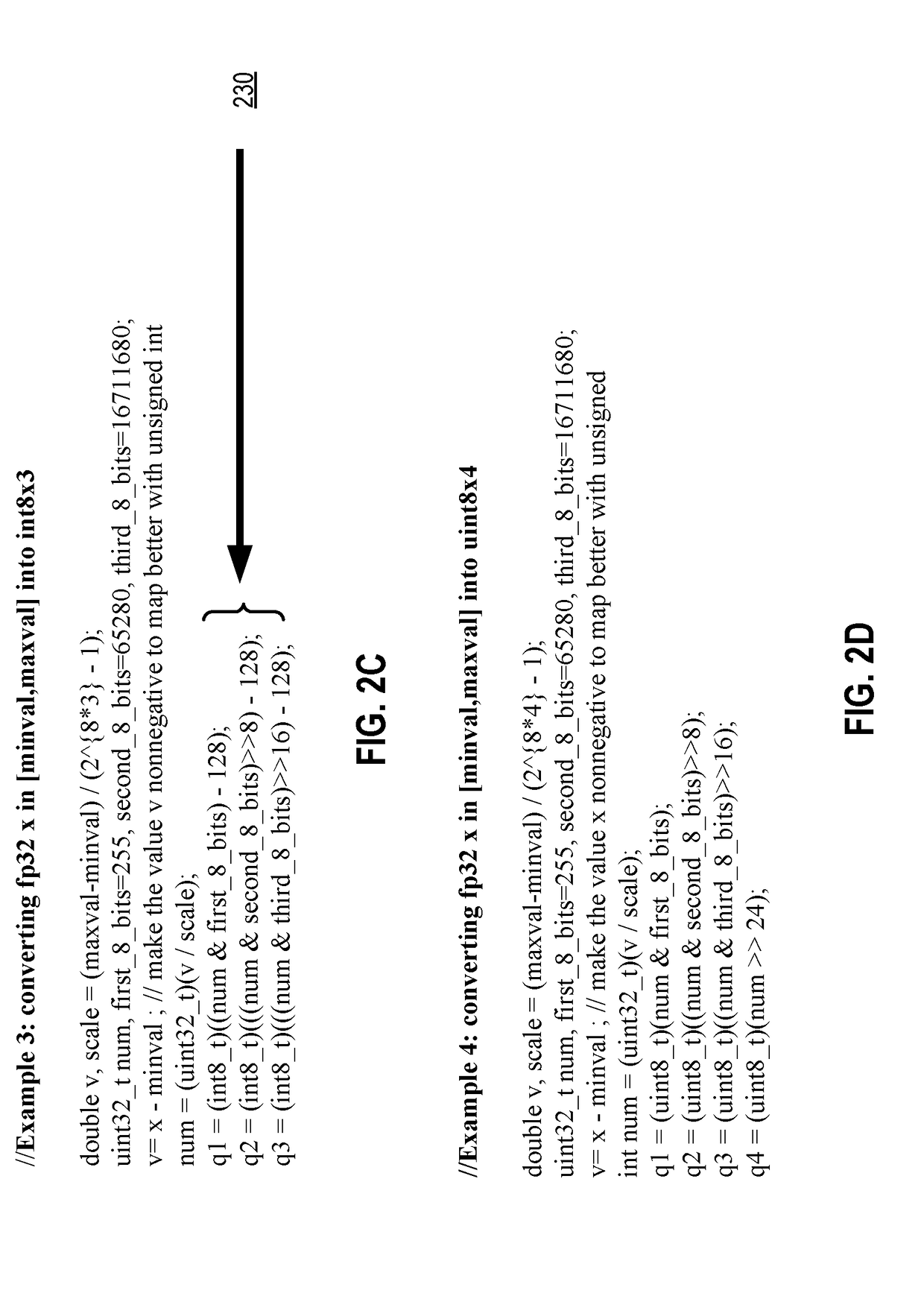Computer processor for higher precision computations using a mixed-precision decomposition of operations
a computer processor and mixed-precision technology, applied in computing, instruments, instruction analysis, etc., can solve the problems of resource intensive and/or time-consuming computing for performing arithmetic operations on floating-point data elements in multi-dimensional data sets
- Summary
- Abstract
- Description
- Claims
- Application Information
AI Technical Summary
Benefits of technology
Problems solved by technology
Method used
Image
Examples
example 1
Converting a FP32 Value Into Three Unsigned Integers, Uint8
[0062]For the conversion, assume that the range of the values is within [Minval, Maxval]. For example, the range of the values of a data array may be [−19, 19], and the value of 17.1 in FP32 is to be quantized. FIG. 2A shows the pseudo code to convert a FP32 value into three unsigned 8-bit integers per one embodiment of the invention. At reference 202, the scale is determined, and it is based on the integer format (uint8) and the number of integers to be used (three). Thus, the scale is (Maxval−Minval) / (2̂(integer length*the number of integers)−1), which is 38 / (2̂(8*3)−1)=38 / 16,777,215=2.2649766*(10̂(−6)) in decimal. The scale may be stored in a register, a cache, or memory.
[0063]Three numbers are then set as masks to obtain the three parts of lower-precision values from the quantized FP32 value at reference 204. The first_8_bits will pick the first 8 bits only since 255 has all ones in binary (bits 0-7); the second_8_bits w...
examples 2-4
Converting a FP32 Value Into Different Numbers of Integers
[0067]Examples 2-4 provide more examples of the quantization of a FP32 value. FIG. 2B shows the pseudo code to convert a FP32 value into two unsigned 16-bit integers per one embodiment of the invention. The pseudo code is similar to the one in FIG. 2A, but the scale is smaller, and the two 16-bit values q1 and q2 use more bits than the three 8-bit values q1, q2, and q3, the quantization likely results in a better approximation of the one in FIG. 2A.
[0068]FIG. 2C shows the pseudo code to convert a FP32 value into three signed 8-bit integers per one embodiment of the invention. FIG. 2C is similar to FIG. 2A, and one difference is the generation of the three 8-bit values at reference 230, where the values of q1, q2, and q3 are subtracted of 128 (27) base on the range of the signed 8-bit integer (from the range of unsigned integers of [0, 28−1] to the range of signed integers of [−27, 27−1]).
[0069]FIG. 2D shows the pseudo code to...
example 5
Reconstructing a FP32 Value From Four Signed Integers
[0072]Once the multiple integer values from the quantization and split perform arithmetic operations, they are reconstructed to return a final result in the float-point format that the initial value was in. FIG. 2E shows the pseudo code to reconstruct a FP32 value from four signed 8-bit integers per one embodiment of the invention. The scale remains the same as another example of converting into four unsigned integers in FIG. 2D as the same number of bits (32 bits) are used for quantization and reconstruction, even though here the signed integers are used in FIG. 2E. The reconstructed intermediate value is num, which is obtained at reference 240 through adjusting the range based on the range of a signed 8-bit integer (int8), and then bit-shifting since the four signed integers from the arithmetic operations correspond to different bit positions of the final results. The intermediate value, which is an integer represented by the fu...
PUM
 Login to View More
Login to View More Abstract
Description
Claims
Application Information
 Login to View More
Login to View More - R&D
- Intellectual Property
- Life Sciences
- Materials
- Tech Scout
- Unparalleled Data Quality
- Higher Quality Content
- 60% Fewer Hallucinations
Browse by: Latest US Patents, China's latest patents, Technical Efficacy Thesaurus, Application Domain, Technology Topic, Popular Technical Reports.
© 2025 PatSnap. All rights reserved.Legal|Privacy policy|Modern Slavery Act Transparency Statement|Sitemap|About US| Contact US: help@patsnap.com



